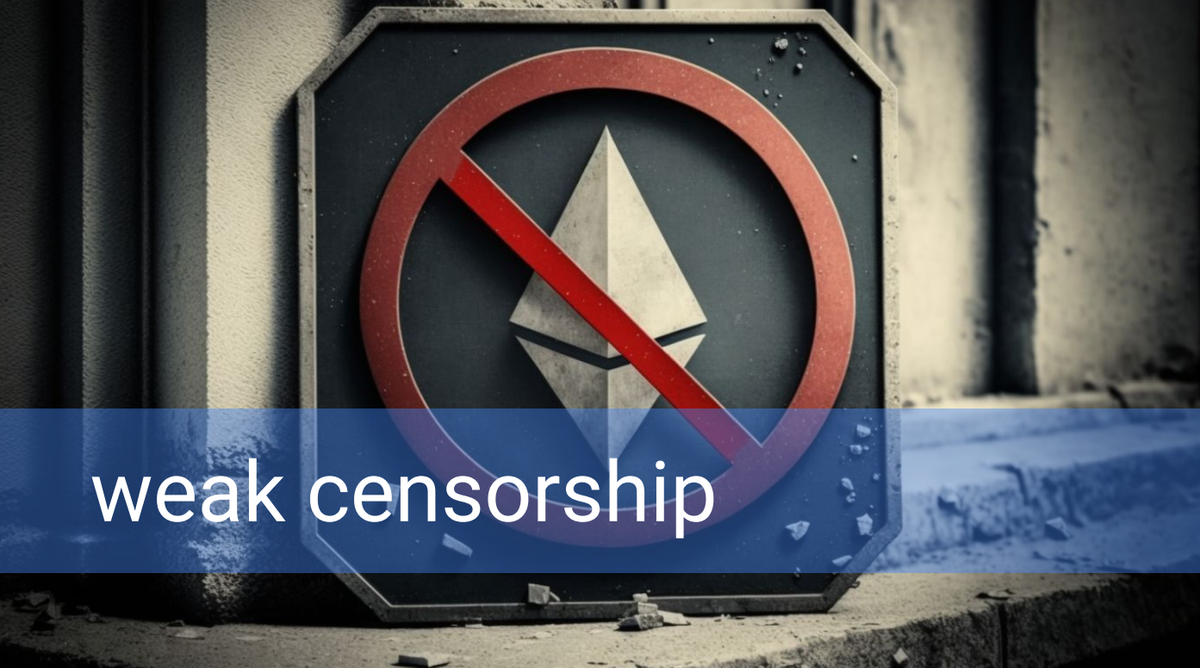Weak Censorship Resistance - Censorship.wtf
Source : https://www.youtube.com/watch?v=sTfATirYqGA

Definitions
Censorship definition (0:50)

Censorship can be seen as an "append test". If a publicly available transaction didn't make it into a block, ask if it could have been appended to the end of that block :
- If yes, it was censored
- If no (e.g. invalid transaction, block was full, validator offline), then it was not censored.
Weak & Strong censorship (1:45)

Two types of censorship :
- Weak censorship - Transaction is delayed by seconds/minutes but eventually makes it on-chain.
- Strong censorship - Transaction is permanently blocked from getting on-chain. Equivalent to a 51% attack.
So far on Ethereum there has only been weak censorship, no observed cases of strong/permanent censorship. This talk will focus on weak censorship that causes transaction delays.
MEV Pipeline (2:30)

The MEV pipeline starts with the user and ends with the attester
- The user and wallet are in the "private domain" off-chain, not much can be done about that.
- Weak censorship originates in the middle of the pipeline, from the searcher to the proposer.
- Strong censorship comes from attesters/validators, equivalent to a 51% attack.
Weak censorship happens between the private user domain and the attesters, from searchers identifying MEV opportunities to proposers including or excluding certain transactions.
We will focus on how weak censorship arises in the searcher-proposer part of the MEV pipeline.
Problems
Overview (3:20)

Roughly speaking, the less important problem is actually latency. It's the one that people think about immediately, but it's the less important one.
The most important one is the inclusion mimetics, at least in Justin Drake's (the speaker) opinion
Inclusion latency (4:00)


Inclusion latency formula : take the normal latency (e.g. 12 seconds) and divide by the fraction of uncensored blocks.
This shows how censorship increases latency. Example: If only 25% of blocks are uncensored, the latency is multiplied by 4x. This affects Tornado Cash transactions today, as ~75% censorship means 4x increased latency.
Inclusion bandwidth affects rollups. If a rollup is censored, it can only use the uncensored block space.
Example: If 25% of blocks are uncensored, an affected rollup can only use 25% of the bandwidth/capacity (like Aztec)
Increased latency can be tolerated, but reduced bandwidth/capacity severely impacts rollups and is a bigger issue than latency.
Memetics (6:00)


The biggest issue with weak censorship is the negative perception and "bad optics" of having the majority of Ethereum blocks censored.
This makes it look like governments have indirect influence over Ethereum. Censorship is viewed negatively, so this is bad for Ethereum's image and marketing. It has been used to criticize Ethereum by journalists, bitcoiners, etc.
Fixing censorship is important because censorship resistance is the start of a "mimetic chain" leading to social legitimacy and monetary premium.
L1 censorship today (7:20)

Currently 5 of the top 6 Ethereum builders/validators (60%+ of blocks) are censoring transactions.
In total around 75% of Ethereum block space is being censored by major builders/validators.
Precarious situation (7:50)


The censorship situation is worsening, with previously uncensoring builders like Beaver and Gambit recently starting to censor transactions.
The share of self-built uncensored blocks is also shrinking over time as more validators activate MEV-boost instead of self-building.
Searchers have a lot of power : if a major searcher like Citadel only provides bundle flows to censoring builders, neutral builders will be forced out of business.
If major searchers start funneling bundles exclusively to censoring builders, this could lead to an eradication of neutral builders, with only 6% uncensored block space remaining from validators self-building blocks.
Solutions
Overview (10:15)


There are 4 solutions that can help address censorship :
- Encrypted mempools : Gives users the ability to encrypt transactions to resist censorship.
- Inclusion lists : Empowers proposers to force include certain transactions, resisting censorship.
- MEV burn : Requires proposers to pick most valuable blocks, making censorship expensive.
- Enshrined Proposer-Builder Separation : Allows relays to avoid censorship by disappearing if needed.
Enshrined PBS (11:45)

The idea of ePBS is to remove the relays completely, so relay censorship goes to zero (simple as that).
Forward inclusion list (12:00)

Proposers can self-build a block template that the next builder must include all transactions from, but can reorder/add transactions.
Without inclusion lists, neutral block space is just what neutral builders produce. With inclusion lists, there is additional neutral block space from proposers forcing transactions into blocks.
Example:
- 50% neutral builders
- 50% proposers forcing inclusion
Total would be 50% + 50% = 100%, but there's a 25% overlap. So net neutral block space is 75%
Inclusion lists can significantly increase layer 1 neutral/uncensored block space beyond just what neutral builders create.
Encrypted mempools (13:30)

Currently the cost of censorship is very low. In fact, this is just the small tips of the few censored transactions.
Encrypted mempools transform the cost to the sum of tips of all encrypted transactions. This is because to censor, builders either have to:
- Include encrypted transactions, but risk including censored ones
- Or censor all encrypted transactions
If most transactions are encrypted, builders essentially have to censor everything. This dramatically increases the cost of censorship.
MEV Burn (15:10)

MEV burn adds base fees of censored transactions to the cost of censorship, in addition to tips.
Tips are around 1 gwei per gas, but base fees are around 30 gwei per gas. So MEV burn creates a 30x increase in censorship costs.
Combined with encrypted mempools, the total cost would make censorship unprofitable for builders.
Mandatory inclusion lists (17:00)

An additional idea is maximizing inclusion list base fees, similar to MEV burn. This incentivizes proposers to include all transactions in inclusion lists.
Despite the precarious situation, Justin thinks it's a matter of time until these solutions are implemented and weak censorship is solved.